 Website:
Meyer Werft
Website:
Meyer Werft
Catalog excerpts

SOCIAL RESPONSIBILITY
Open the catalog to page 1
“SUCCESSFUL MANAGEMENT OF A SHIPYARD IS A HOLISTIC PROCESS THAT NECESSITATES CONSTANT QUESTIONING AND IMPROVEMENT” BERNARD MEYE
Open the catalog to page 3
PAPENBURG A PLACE OF SHIPBUILIDING CORPORATE ENVIRONMENTAL PROTECTION EDUCATION, HEALTH & SOCIAL MATTERS
Open the catalog to page 6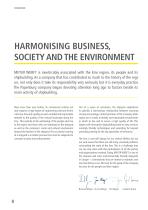
HARMONISING BUSINESS, SOCIETY AND THE ENVIRONMENT MEYER WERFT is inextricably associated with the Ems region, its people and its shipbuilding. As a company that has contributed so much to the history of the region, not only does it take its responsibility very seriously but it is everyday practice. The Papenburg company began devoting attention long ago to factors beside its main activity of shipbuilding. Now more than ever before, its commercial activity not only requires a high degree of engineering craft and technical know-how but equally an open-minded and responsible attitude to the...
Open the catalog to page 8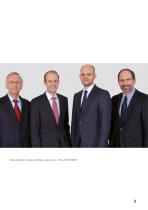
Bernard Meyer, Dr. Jan Meyer, Tim Meyer, Lambert Kruse – CEOs of MEYER WERFT
Open the catalog to page 9
PAPENBURG A PLACE OF SHIPBUILDING SINCE 1795
Open the catalog to page 10
1. PAPENBURG – A PLACE OF SHIPBUILDING SINCE 1795 TRADITION AND SELF-IMAGE The Meyer family has been keeping its shipyard on a steady course for seven generations now. The shipbuilding company was founded in 1795, and it remains in family ownership to this day. The successful development of the company is rooted in tradition and innovation. The MEYER WERFT shipyard was the first compact shipyard in Europe and is one of the most modern shipyards in the world today. Comprising two covered dry docks with computer-assisted production facilities and equipped with the latest technology, everyday...
Open the catalog to page 12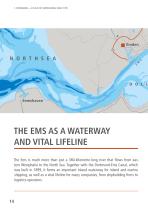
1. PAPENBURG – A PLACE OF SHIPBUILDING SINCE 1795 THE EMS AS A WATERWAY AND VITAL LIFELINE The Ems is much more than just a 380-kilometre-long river that flows from eastern Westphalia to the North Sea. Together with the Dortmund-Ems Canal, which was built in 1899, it forms an important inland waterway for inland and marine shipping, as well as a vital lifeline for many companies, from shipbuilding firms to logistics operators.
Open the catalog to page 14
Weener. Conneforde-Diel Thousands of tonnes of goods including cars, timber and plastics are handled on both sides of the Ems in the harbours of Dorpen, Papenburg, Leer, Emden and Haren on the German side and in Eemshaven and Delfzijl in the Netherlands. The volume of goods handled has increased continually over the past two decades. The regional port economy is on a successful course and more than 9,000 ships travel along the river each year - an economic growth that is also changing the demands placed on the river. In addition to this, shipbuilding enjoys a centuries-long tradition on the...
Open the catalog to page 15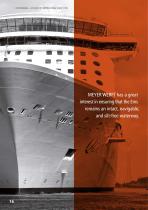
1. PAPENBURG – A PLACE OF SHIPBUILDING SINCE 1795 MEYER WERFT has a great interest in ensuring that the Ems remains an intact, navigable, and silt-free waterway.
Open the catalog to page 16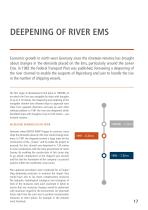
DEEPENING OF RIVER EMS Economic growth in north west Germany since the nineteen-nineties has brought about changes in the demands placed on the Ems, particularly around the Lower Ems. In 1982 the Federal Transport Plan was published, foreseeing a deepening of the river channel to enable the seaports of Papenburg and Leer to handle the rise in the number of shipping vessels. The first stage of development took place in 1985/86, after which the Ems was navigable by ships with draughts of up to 5.70 metres. The deepening and widening of the navigable channel now allowed ships to approach each...
Open the catalog to page 17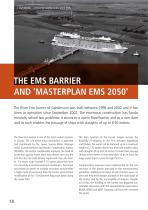
1. PAPENBURG – A PLACE OF SHIPBUILDING SINCE 1795 THE EMS BARRIER AND 'MASTERPLAN EMS 2050' The River Ems barrier of Gandersum was built between 1998 and 2002 and it has been in operation since September 2002. The enormous construction has fundamentally solved two problems: it serves as a storm-flood barrier and as a river dam and as such enables the passage of ships with draughts of up to 8.50 metres. The River Ems barrier is one of the most modern barriers in Europe. The 476-metre long construction is operated and maintained by the Lower Saxony Water Management, Coastal Defence and Nature...
Open the catalog to page 18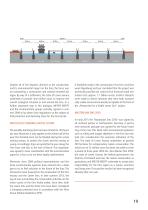
Main gate Inland shipping Despite all of the disputes directed at the construction and its environmental impact on the Ems, the focus was on maintaining a constructive and solution-oriented dialogue. By way of a settlement, the state of Lower Saxony undertook to provide nine million euros to improve the overall ecological situation in and around the Ems. In a further important step in this dialogue, MEYER WERFT and the environmental groups amicably agreed in summer 2009 to lay down clear regulations on the subject of bird protection and damming times for the Ems barrier. METICULOUS PLANNING...
Open the catalog to page 19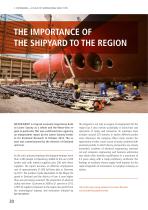
1. PAPENBURG – A PLACE OF SHIPBUILDING SINCE 1795 THE IMPORTANCE OF THE SHIPYARD TO THE REGION MEYER WERFT is of great economic importance both to Lower Saxony as a whole and the Weser-Ems region in particular. This was confirmed once again by an independent report by the Lower Saxony Institute for Economic Research in October 2014. The report was commissioned by the districts of Emsland and Leer. As the city‘s primary employer, the shipyard employs more than 3,300 people in Papenburg. Added to this are 2,200 further jobs with indirect suppliers plus 200 with direct suppliers. The report...
Open the catalog to page 20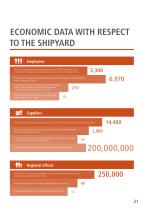
ECONOMIC DATA WITH RESPECT TO THE SHIPYARD Employees There are 3,300 people who are directly employed at MEYER WERFT, 94% of whom live in the districts of Emsland and Leer. The shipyard provides more than 21,000 jobs in total. The total direct and indirect employment effect in the region and the districts of Emsland and Leer amounts to approx. 6,970 jobs. The training activities and 270 training places at MEYER WERFT and its supplier companies make an essential contribution to improving the level of qualification in the region. The average age of employees is 38 years and the average length...
Open the catalog to page 21
1. PAPENBURG – A PLACE OF SHIPBUILDING SINCE 1795 „THE CRUISE SHIP SECTOR FACES SERIOUS CHALLENGES!“ Interview with Bernd Stecker, professor of leisure and tourism policy & planning, ecology and sustainability at Bremen University of Applied Sciences
Open the catalog to page 22All Meyer Werft catalogs and brochures
-
Passenger ships for indonesia
12 Pages


